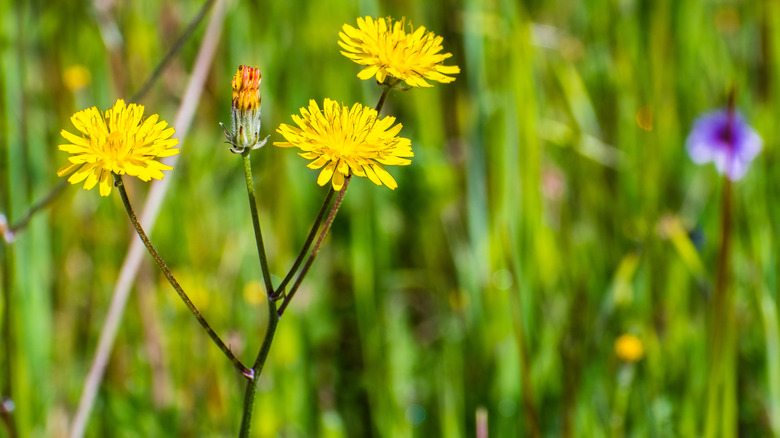If reminiscing on your childhood doesn’t bring up memories of playing with dandelions (Taraxacum officinale), did you ever spend time outside? These plants, officially classified as weeds, brought us a lot of joy. It wasn’t until we grew up that we learned that dandelions are edible. However, there is another plant out there that looks identical to this yellow flower and that can also be consumed but comes with some other negative traits. The cat’s ear plant (Hypochaeris radicata) is the dandelion’s mischievous twin that looks similar in almost every way, minus several structural and color differences in the flowers, stems, and leaves. Also called the false dandelion, the cat’s ear is toxic to horses and could overtake your garden, unlike its counterpart. Therefore, it’s important to be able to tell these two plants apart so you don’t accidentally allow cat’s ear to stay in your yard.
Dandelions are weeds first and foremost, but over the years, they’ve been discovered to be a source of healthy nutrients and may even encourage the secretion of insulin, which is great news for people with diabetes. Because of these revelations, more people have started eating this plant as a source of greens. The root can be used to make tea, or the whole plant can simply be eaten. While cat’s ear is also edible and could improve your health, it isn’t meant to be taken in large quantities by humans and should never be fed to horses.
How to tell cat’s ears and dandelions apart

Dandelions and cat’s ears have similar-looking yellow flowers with numerous long petals, so telling them apart can be challenging. Differentiating true dandelions from cat’s ears is all in the leaves. Young dandelion leaves are light green and smooth, while cat’s ear leaves are a darker shade of green and covered with dense hairs, the feature that earned them their name. Another tell-tale way you can tell them apart is that while cat’s ear leaves have slightly-jagged edges, dandelion leaves have a jaggedness that runs further toward the main middle veins. There’s also a stem difference. Cat’s ears have solid, forked stems that produce multiple flowers on one plant, while dandelions have hollow, unforked stems that produce just one flower.
If you get the urge to nibble on plant leaves during a hike and you come across either one of these two plants, you can probably also tell them apart by how bitter the leaves are. Dandelion leaves are very bitter when raw and they only get milder when cooked. On the other hand, cat’s ears have very mild leaves with only a slight trace of bitterness. Since they’re both safe for humans, you could do a taste test and check. Finally, you can determine which plant you’ve come across by the season. Dandelions are mostly in bloom during the early part of spring, while cat’s ears are common garden weeds that are more prolific at the beginning of summer.
Dandelions are generally garden-safe while cat’s ears are not

Telling dandelions apart from cat’s ears is necessary to preserve the life and health of horses. Because these weeds can grow in a variety of places, it may be easy for your horse to find it along its grazing path. However, they should not be allowed to eat it, as it can cause stringhalt, a motor disorder characterized by jerky movements of their hind legs. According to PennState Extension, it should not be allowed to grow in gardens with horses nearby, and humans should take care not to eat too much of it.
Another key difference between these weeds is that cat’s ear is considered invasive, meaning that it spreads quickly and could overtake your other plants. If you have a garden, keep these blooms away from it. Uproot the ones you find by digging about 8 centimeters deep into the soil around the plant and removing the roots. Dandelions, however, are not considered invasive weeds and can actually benefit your lawn. Regardless, they’re still a nuisance that you don’t want to see too much of in your garden, and they can be removed in the same way by digging out the roots. If you find dandelion or cat’s ear seed heads around your home, resist the urge to relive your fun childhood memories by blowing them into your yard. This would help them disperse by wind and settle in your garden, leading to lots of blooms later on.



